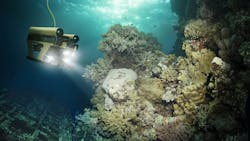Quiescent Imaging for Deep-Sea Studies
This article is in TechXchange: Why Low Iq is the Smart Thing to Do.
Members can download this article in PDF format.
What you'll learn:
- What is quiescent imaging, and how it has evolved.
- A look at the HOV Alvin submersible.
- The evolving digital still camera and improvements in subsea lighting.
Deep-sea science has been a big user of underwater quiescent imaging, dating back to the 19th century. However, thanks to digital imaging, undersea imaging has taken a significant leap forward in this century—faster than in any previous time.
Quiescent imaging requires a user to initially set up a fixed-focus camera to record still or motion imaging over fixed time intervals with no further user interaction.
According to the National Oceanic and Atmospheric Administration (NOAA), more than 80% of the mysteries of the oceans haven’t yet been explored or even discovered. On that front, the Multidisciplinary Instrumentation in Support of Oceanography (MISO) Facility, at the Woods Hole Oceanographic Institution (WHOI), performs high-resolution subsea imaging which is at the heart of their research.
Subsea Quiescent-Imaging History
The earliest days of underwater photography began in the 1860s when French inventor Ernest Bazin took photographs from a deep-sea diving bell. Almost a century later, an engineering professor at MIT named Harold Edgerton created the deep-sea strobe light, which provided the “sunlight” effect that was necessary to photograph the deep ocean and its seafloor for the first time ever.
That innovation, along with the engineering efforts at the WHOI and the Lamont Geological Observatory of Columbia University, gave way to the first generation of modern-day deep-sea cameras. Those cameras gave photographic proof that there was life and unique seafloor features within small regions of the deep ocean.
Fast forward to modern quiescent digital imaging, which was able to image large regions that then could be merged into a photomosaic. This provided a powerful mapping tool capability along with a deeper knowledge of geological relationships among features of many dimensions. The tool enabled such images in sizes from centimeter scale to tens or hundreds of meters.
The HOV Alvin Submersible Vehicle
The HOV Alvin, first commissioned in 1964, was one of the key pioneers of deep-ocean submersibles, able to perform data collection while situated far below the sea (Fig. 1).
This amazing underwater vehicle can carry two scientists to depths of 6,500 meters while on dives that could last as long as 10 hours. In 2021, upgrades were completed that enabled a larger personnel sphere with better visibility as well as overlapping fields of view. The vehicle bottom time was extended, and lighting was improved.
In addition, better state-of-the-art sensors were added, along with enhanced data acquisition as well as faster download speed. The upgrade also was able to increase the science basket payload by a factor of two, and the command-and-control system was upgraded for greater speed, maneuverability, and range.
The Digital Still Camera
A digital still-camera system design (Fig. 2) must include:
- A highly efficient, high-quality, power-management system, with ultra-low quiescent current, which will extend battery runtime.
- Smart stepper-motor drivers, with high efficiency, taking up minimal board space and maintaining a precise motion-control system.
- Sensors that are accurate as well as efficient to give the best image quality.
4K video imaging is crucial to deep-sea science objectives; that’s why a MISO-OIS GoPro 12MP camera was chosen. This camera used quiescent fixed focus to record 4K video internally.
A second camera was controlled via a user within the HOV Alvin. This camera was a DeepSea Power & Light Apex SeaCam 4K camera that offers:
- Remote recording with a live view.
- Ability of close-up inspection details.
- An active input for zoom as well as focus.
- Up to four days of continuous 4K recording.
- 6-km depth rating.
A unique image was captured by a MISO-OIS GoPro 12MP camera on the HOV Alvin: It sampled approximately 360°C hydrothermal fluids from the Bio9 vent at the East Pacific Rise axis at a depth of 2,510 m (Fig. 3). Rapid five-second interval quiescent imaging documented seafloor features with no need for any other resources from either the pilot or the two observers on the Alvin.
Subsea Lighting
When a subsea camera is lowered into the depths of the ocean, ambient light will decrease with depth. Capturing subsea images requires LED lighting as the best solution because it’s long-lasting, rugged, and can perform in both short- and long-term underwater projects.
The SubC Imaging Aquorea Mk3 Colour is a high-efficiency, TTL-synchronized, subsea LED that will simultaneously operate as a lamp and a strobe. It’s available in various custom wavelengths. Each LED color is designed for specific deep-sea applications:
- Far-red helps to capture deep-water natural species behavior.
- Deep-blue is perfect for bio-fluorescence and leak detection.
Lasers
The Ocean Imaging Systems Model 400-37 laser functions as a scaling device for digital cameras. Usually, two or four lasers will place two laser dots, a known distance apart, within the field of view of the underwater camera. These dots serve as a known reference that will lead to the scale of the objects within the image.
Sediment Profile Imaging
Sediment profile imagery (SPI) is an underwater technique that photographs the interface between the seabed and the water above it. This method can be employed to measure biological, chemical, and physical processes occurring in the first few centimeters of sediment, pore water (water contained in pores in soil or rock), and the all-important benthic boundary layer of water.
Summary
Quiescent digital imaging, under the deep blue sea, has made monumental strides in capturing images that never had been seen beforehand. As technology progresses, for deep-sea imaging cameras and submersible technology, new technologies and insights will arise to further the study of deep-sea creatures and their habitats.
The two major areas that scientists will be exploring, as we move along in the 21st Century, are space and Earth’s vast oceans. These efforts will surely help to satisfy human explorers’ curiosity regarding “what’s out there” beyond our present borders above and below our Earthly home.
References
Discovery of active off-axis hydrothermal vents at 9° 54′N East Pacific Rise, PNAS, July 21, 2022.
Quiescent Imaging for Deep-Sea Science: Advances in Technology and Productivity.
About the Author

Steve Taranovich
Freelance Technical Writer, Phoenix Information Communication LLC
Steve is a contributing editor to Electronic Design.
Author of the non-fiction “Guardians of the Right Stuff,” a true story of the Apollo program as told by NASA and Grumman Corp. engineers, an astronaut, and technicians.
Experienced Editor-In-Chief of EETimes/Planet Analog and Senior Technical Editor at EDN running the Analog and Power Management Design Centers from 2012 to 2019.
A demonstrated history in electronic circuit design and applications for 40 years, and nine years of technical writing and editing in industry. Skilled in Analog Electronics, Space-related Electronics, Audio, RF & Communications, Power Management, Electrical Engineering, and Integrated Circuits (IC).
1972 to 1988 worked as a circuit design engineer in audio (8 years) and microwave (8 years). Then was Corporate Account Manager/applications engineer for Burr-Brown from 1988 to 2000 when TI purchased Burr-Brown. Worked for TI from 2000 to 2011.
Strong media and communication professional with a BEEE from NYU Engineering in 1972 and an MSEE from Polytechnic University in 1989. Senior Lifetime member of IEEE. Former IEEE Long Island, NY Director of Educational Activities. Eta Kappa Nu EE honor society member since 1970.



